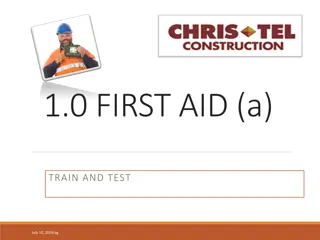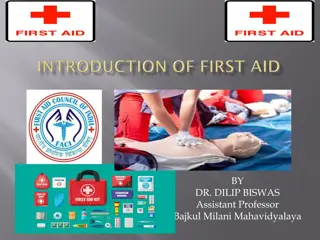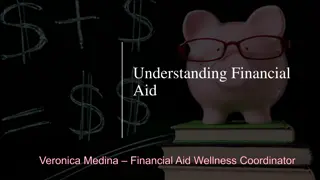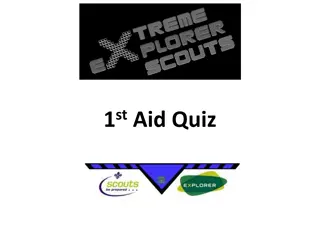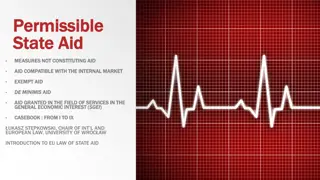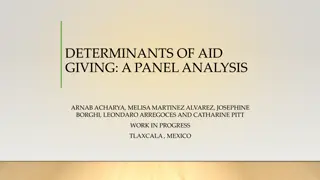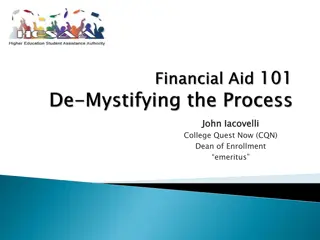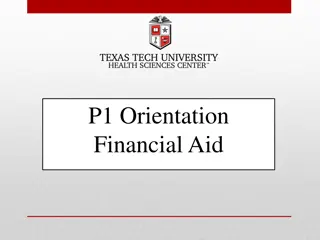Essential First Aid Principles and Steps
Providing immediate first aid is crucial in minimizing the effects of injuries or illness. To deliver effective care, you must remain calm, evaluate the situation, and adjust treatment based on various factors. Recognizing emergencies, checking the scene for safety, obtaining permission, and protecting the victim are essential steps in first aid. It's important to reassure and avoid unnecessary movements, work efficiently, protect from cold or overheating, maintain confidentiality, and only provide qualified treatment.
Download Presentation

Please find below an Image/Link to download the presentation.
The content on the website is provided AS IS for your information and personal use only. It may not be sold, licensed, or shared on other websites without obtaining consent from the author. Download presentation by click this link. If you encounter any issues during the download, it is possible that the publisher has removed the file from their server.
E N D
Presentation Transcript
CHAPTER 16 First Aid
16:1 Providing First Aid Immediate care given to the victim of an accident or illness to minimize the effect of injury or illness until experts can take over Reasons for providing correct first aid
Basic Principles of Providing First Aid Remain calm and avoid panic Evaluate situation thoroughly Have a reason for anything you do Treatment you provide will vary depending on type of injury or illness, environment, others present, equipment or supplies on hand, and availability of medical help
First Steps Recognize that an emergency exists Use all senses to detect problems Sometimes signs of emergency are obvious and at other times they are less obvious
Next Steps Check the scene and make sure it is safe to approach What to observe If not safe, call for medical help If safe, approach the victim Call emergency medical services (EMS) as soon as possible (continues)
Next Steps (continued) If possible, obtain the victim s permission before providing any care Triage if necessary Check for other injuries Obtain as much information as possible before you proceed
General Principles Obtain qualified help Avoid any unnecessary movement of the victim Reassure the victim Use a confident, calm attitude to help relieve victim s anxiety Avoid giving the victim anything to eat or drink (continues)
General Principles (continued) Protect the victim from cold or chilling, but avoid overheating Work quickly in an organized and efficient manner Do not make a diagnosis or discuss condition with observers at scene (continues)
General Principles (continued) Maintain confidentiality and protect the victim s right to privacy while providing treatment Make every attempt to avoid further injury or harm Provide only the treatment you are qualified to provide
16:2 Performing CPR Cardiopulmonary resuscitation (CPR): Cardio: the heart Pulmonary: the lungs Resuscitation: to remove from apparent death or unconsciousness When performing CPR, you breathe for the patient and circulate blood (continues)
Performing CPR (continued) Purpose: keep oxygenated blood flowing to the brain and other vital body organs Performed until the heart and lungs start working again or until medical help is available Clinical versus biological death (continues)
Performing CPR (continued) ABCDs of CPR A stands for airway B stands for breathing C stands for circulation D stands for defibrillation (continues)
Performing CPR (continued) Evaluate victim s condition before starting CPR: Check if patient is conscious If unconscious, check for breathing If not breathing, place victim on back Open the airway by using the head-tilt/chin lift or jaw-thrust maneuver (continues)
Performing CPR (continued) Look for chest movement Listen for breathing Feel for movement of air from the nose or mouth If not breathing, give two breaths Make sure breaths are effective Then check the carotid pulse (continues)
Performing CPR (continued) Correct hand placement is needed before performing chest compressions Various methods of CPR used One-person adult rescue for adult 30 compressions followed by 2 ventilations (30:2 ratio) (continues)
Performing CPR (continued) Two-person adult rescue for adult 30 compressions by one rescuer followed with 2 ventilations by the second rescuer (30:2 ratio) CPR for infants (birth to one year) 30 compressions followed by 2 ventilations for one rescuer (30:2 ratio) 15 compressions followed by 2 ventilations for two rescuers (15:2 ratio) (continues)
Performing CPR (continued) CPR for children (1 year to puberty) 30 compressions followed by 2 ventilations for one rescuer (30:2 ratio) 15 compressions followed by 2 ventilations for two rescuers (15:2 ratio) CPR for choking victims Reasons for stopping CPR
STROKE Act FAST F Face-Ask the person to smile. Look to see if it's uneven A= Arms-Ask the person to raise both arms. Check if one arm is weak S= Speak-Ask the person to speak. Listen for slurring T= Time-Call 911 at the first sign of stroke.
Providing First Aid for Bleeding and Wound
16:3 Providing First Aid for Bleeding and Wounds Wound is an injury to soft tissues Open: break in skin or mucous membranes Closed: no break in skin or mucous membranes, but injury occurs to underlying tissues Wounds can result in bleeding, infection, and/or tetanus
Classifications of Open Wounds Abrasion Skin is scraped off http://t3.gstatic.com/images?q=tbn:ANd9GcRo1YslQ5IdztEzaHbDSYTxSIM5aU80E8uZuEFQ2mxBobUiIemZ Incision Cut caused by a sharp object- knife, razor , blade
Classification of Wounds Laceration Cut with tearing of tissue by a sharp object http://t2.gstatic.com/images?q=tbn:ANd9GcQtcqXFCAAvVW7wzyDTL9rSnWzKV1hG02jhpQkxivivPMkiKcLm0g:www.eatonhand.com/jpg/1492704.jpg Puncture Cut caused by a pointed object http://t2.gstatic.com/images?q=tbn:ANd9GcQQqNc5wx8JOnDjviZxUFs4T0y_1uCgSeVBFt582AH8eOH30p-I:images.medindia.net/patients/first-aid/images/300x250/puncture-wounds.jpg
Classifications of Open Wounds Avulsion Tissue is torn or separated from the victims body http://t0.gstatic.com/images?q=tbn:ANd9GcT9ELMZhf6gzR5pjXgfm___ifV7fvDCSrlILExtrMrUvq8dhdOeGA:3.bp.blogspot.com/-x3C3T0qS0xI/T6bDl4s-9vI/AAAAAAAAChk/fKQ0hspk5f4/s1600/IMG_9199.JPG Amputation Body part is cut off and separated from the body http://t0.gstatic.com/images?q=tbn:ANd9GcSKxa7mIFii6DaCZuBxnJhnqVXFGFaB2olHWT29nptx_CmssFdw:woundcaresa.com/photogallery/photo17728/Amputation.jpg
Controlling Bleeding First priority because victim can bleed to death quickly Bleeding can come from arteries, veins, or capillaries Observe standard precautions (continues)
Controlling Bleeding (continued) Direct pressure Pressure applied with gauze- use a clean cloth if sterile gauze not available Elevation Above the level of the heart- gravity helps to stop bleeding Pressure bandages Direct pressure and elevation are used Pressure on pressure points Main blood supply to the affected area helps minimize blood loss
Controlling Bleeding Do not disturb clots Clots are a natural defense in the bodies attempt to stop bleeding Do not remove dressings May result in additional bleeding Do not clean wound May also lead to further bleeding
Minor Wounds First priority prevention of infection Wash your hands thoroughly before caring for wound Put on gloves Wash the wound with soap and water Rinse the wound Use sterile supplies
Signs of Infection Swelling Heat Redness Pain Fever Pus Red streaks Seek prompt medical care if any of the above occur
Tetanus Tetanus bacteria can easily enter an open wound Tetanus is a serious illness caused by Clostridium bacteria The infection causes painful tightening of the muscles, usually all over the body. It can lead to "locking" of the jaw. This makes it impossible to open your mouth or swallow. Tetanus is a medical emergency. You need to get treatment in a hospital Most common in puncture wounds Assess for last tetanus shot Serious illness Get tetanus shot or booster as needed
Objects Embedded in Wound Examples such as splinters, pieces of glass, or small stones If superficial, gently remove Objects embedded in tissues should be left and removed by physician
Closed Wounds Can occur anywhere on body If bruise, apply cold application to reduce swelling Observe for signs of internal bleeding Get medical help Check breathing and treat for shock Avoid unnecessary movement No food or fluids
What should you do? You are slicing carrots and cut off the end of your finger--- - What should you do??????
What Should You Do? You are watching TV with your parents. Suddenly your father c/o Severe chest pain radiating down his left arm Shortness of breath Lips are cyanotic Skin is diaphoretic What should you do?
Inflammatory Response INJURY (bacteria, physical trauma, heat) injured cells release chemicals (like histamine, kinins) blood vessels dilate and capillaries become leaky- injury attracts WBC s and phagocytes- dilation of blood vessels causes increased blood flow to area ( ie. redness)- swelling caused by fluid leaking out of capillaries WHY DOES OUR BODY RESPOND THIS WAY? - Prevents spread of damaging agents to nearby tissues - Disposes of pathogens/debris - Clotting proteins/ fibrin wall off damaged area and prevent spread of pathogen
16:4 Providing First Aid for Shock Also called hypoperfusion Can exist with any injury or illness Shock: clinical set of signs and symptoms that are associated with an inadequate supply of blood to body organs, especially brain and heart Just 4-6 minutes of hyoperfusion can cause brain damage Causes of shock Can you name some???
Types of Shock See Table 16-1 in text Anaphylactic Allergic reactions causing histamine release = massive vasodilatation (hives, wheezing, coughing, chest tightness)= give epinephrine Cardiogenic Heart can not pump Hemorrhagic Excessive blood loss Respiratory Gas exchange is altered (continues)
Types of Shock Psychogenic Severe emotional distress- anger, fear, grief cause dilation of blood vessels (fainting) Septic Infections or poisoning causing severe vasodilatation Metabolic Causing changes in normal balance or homeostasis of the body Loss of fluids from extreme vomiting, diarrhea, and heat Neurogenic Sympathetic nervous system can t control the size of blood vessels Injury and/or trauma to the spinal cord, general anesthesia,
Signs and Symptoms of Shock Skin is pale or bluish-gray and cool or cold to the touch Diaphoresis Rapid and weak pulse Respirations rapid, shallow, and may be irregular Blood pressure very low or unobtainable (late sign of shock) (continues)
Signs and Symptoms of Shock (continued) General weakness Anxiety and extreme restlessness Excessive thirst Nausea and/or vomiting Blurred vision or changes in appearance of eyes
Treatment for Shock Goals of treatment- Shock states are life threatening SEEK MEDICAL ATTENTION STAT Improve circulation especially to the heart and brain Provide oxygen Maintain body temperature *****Reduce effects of or eliminate the cause
Shock Positioning of victim Best position is supine with legs elevated 12 inches DO NOT move Pt if neck or spine injuries are suspected unless pt in danger Put on side if mouth bleeding or vomiting Raise head and shoulders if respiratory problems Maintain body temperature cover the victim with blankets to prevent chilling and exposure to cold avoid overheating the victim Avoid food or drink DO NOT GIVE anything by mouth
First Aid for Shock Other principles of care- Standard precautions if available! Check the scene Move victim only if absolutely necessary CALL 911 Provide care to the victim Control bleeding Observe for signs of shock
First Aid for Shock Try to reduce or eliminate the cause Control bleeding by applying pressure to sites Provide O2 if possible Attempt to ease the pain through position changes and comfort measures Give emotional support
16:5 Providing First Aid for Poisoning Poison: any substance that causes a harmful reaction to the outside or inside of the body Immediate action is needed First aid varies depending on type of poison, injury involved, and the method of contact Are they breathing? Are they breathing but unconscious?
Ways Poisoning Occurs Ingesting various substances Inhaling poisonous gases Injecting substances Contacting the skin with poison
First Aid for Poisoning If poison has been swallowed Immediate attention before what occurs?? Call poison control center (PCC), 911, or go to ER immediately Save the label or container to give to PCC or MD How much was ingested? Save a sample of vomitus if patient happens to vomit Methods to induce vomiting- caution must be told to do so DO NOT INDUCE VOMITING on a unconscious victim!! Some instructions by PCC may be to tickle back of throat, give warm saltwater to drink, syrup of ipecac/water (can be kept in first aid kit),activated charcoal



